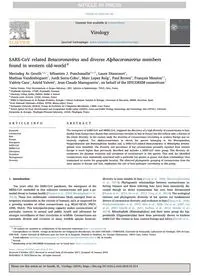
2018 SARS-CoV related Betacoronavirus and diverse Alphacoronavirus members found in western old-world PDF
Preview 2018 SARS-CoV related Betacoronavirus and diverse Alphacoronavirus members found in western old-world
Contents lists available at ScienceDirect Virology journal homepage: www.elsevier.com/locate/virology SARS-CoV related Betacoronavirus and diverse Alphacoronavirus members found in western old-world☆ Meriadeg Ar Gouilha,g,⁎, Sébastien J. Puechmailleb,c,d, Laure Diancourta, Mathias Vandenbogaerta, Jordi Serra-Coboe, Marc Lopez Roïge, Paul Brownh, François Moutouf,1, Valérie Caroa, Astrid Vabretg, Jean-Claude Manuguerraa, on behalf of the EPICOREM consortium2 a Institut Pasteur, Unité Environnement et Risques Infectieux, CIBU, Infection et Epidemiologie, 75015, Paris, France b Greifswald University, 17489, Greifswald, Germany c University College Dublin, Belfield, Dublin 4, Ireland d Chauves-souris Aveyron, 12310, Vimenet, France e IRBIO & Departament de de Biologia Evolutiva, Ecologia i Ciències Ambientals, Facultat de Biologia, Universitat de Barcelona, 08028, Barcelona, Spain f Ecole Nationale Vétérinaire d’Alfort, 94704, Maison-Alfort, France g Normandie Université, EA2656, Groupe de Recherche sur l’Adaptation Microbienne, 14000, Caen, France h French Agency for Food, Environmental and Occupational Health Safety (ANSES), Avian and Rabbit Virology Immunology and Parasitology Unit (VIPAC), Université Européenne de Bretagne, Ploufragan/Plouzané laboratory, 22440, Ploufragan, France A R T I C L E I N F O Keywords: Coronavirus Bats Europe Emergence SARS-CoV MERS-CoV Chiroptera Evolution Phylogenetics Diversity A B S T R A C T The emergence of SARS-CoV and MERS-CoV, triggered the discovery of a high diversity of coronaviruses in bats. Studies from Europe have shown that coronaviruses circulate in bats in France but this reflects only a fraction of the whole diversity. In the current study the diversity of coronaviruses circulating in western Europe was ex- tensively explored. Ten alphacoronaviruses in eleven bat species belonging to the Miniopteridae, Vespertilionidae and Rhinolophidae families and, a SARS-CoV-related Betacoronavirus in Rhinolophus ferrume- quinum were identified. The diversity and prevalence of bat coronaviruses presently reported from western Europe is much higher than previously described and includes a SARS-CoV sister group. This diversity de- monstrates the dynamic evolution and circulation of coronaviruses in this species. That said, the identified coronaviruses were consistently associated with a particular bat species or genus, and these relationships were maintained no matter the geographic location. The observed phylogenetic grouping of coronaviruses from the same species in Europe and Asia, emphasizes the role of host/pathogen coevolution in this group. 1. Introduction Ten years after the SARS-CoV pandemic, the emergence of the MERS-CoV reminded us that unknown coronaviruses still pose a po- tential threat to human health (Drosten et al., 2003; Bermingham et al., 2012). Those two emblematic coronaviruses likely emerged from in- terspecies transmission in the vicinity of humans, such as suspected for a growing number of other coronaviruses (e.g. BCoV/OC43, PRCV, 229E, NL63). This interspecies-jump capacity makes coronaviruses of particular concern to animal and public health and advocates for stronger surveillance of their circulation in wildlife. Coronaviruses are extremely diverse and circulate in many wildlife species however, diversity is most notable in bats (Tang et al., 2006; Wacharapluesadee et al., 2015). Phylogenetic relationships between coronaviruses in- fecting humans and those infecting bats have been extensively dis- cussed though no direct transmission has ever been documented (Huynh et al., 2012; Ge et al., 2013; Yang et al., 2014). The ecological richness and phylogenetic diversity of bat species are fundamental drivers of coronavirus diversity and evolution in bats (Tang et al., 2006; Wacharapluesadee et al., 2015; Woo et al., 2006; Cui et al., 2007; Lau et al., 2007; Gouilh et al., 2011; Balboni et al., 2012; Drexler et al., 2014). Rhinolophids (Rhinolophidae) and their sister group the hip- posiderids (Hipposideridae) have been previously shown to harbour SARS-CoV like viruses in Asia, eastern-Europe and Africa (Gouilh et al., https://doi.org/10.1016/j.virol.2018.01.014 Received 9 October 2017; Received in revised form 22 December 2017; Accepted 18 January 2018 ☆ All authors are members or collaborators of the Epicorem consortium (http://coronavirus.fr). ⁎ Correspondence to: GRAM - Groupe de Recherche sur l'Adaptation Microbienne, EA 2656 UNICAEN / UNIROUEN, Université de Normandie, Laboratoire de Virologie, CHU de Caen, CNR ROR - Centre National de Référence pour les Virus de la Rougeole, Rubéole et Oreillons, Av. Georges Clémenceau, 14033 Caen, Cedex, France. 1 Retired. 2 Membership of the EPICOREM Consortium can be found here: http://coronavirus.fr. E-mail addresses:
